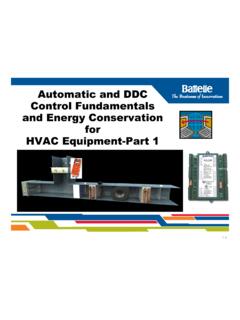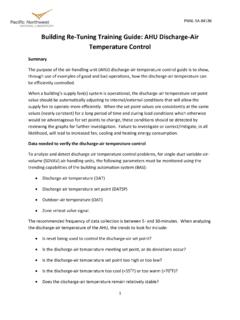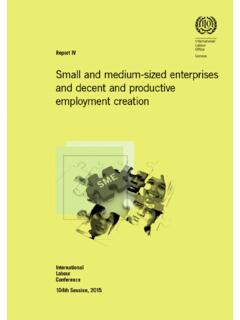Transcription of Small/Medium-Sized Commercial Building Re-tuning Training
1 Small/Medium-Sized Commercial Building Re-tuning TrainingCollecting Building Information and Building Walk-DownA PRESCRIPTIVE APPROACH TO Re-tuning small / medium - sized Commercial BUILDINGSPNNL-SA-92685 4/24/2013 Version - sized Building Re-tuning Training : Collection of Basic Building Information2 Size, age and type of buildingAs-built and construction documentsO&M Manuals, Sequence of Operations (SOP)Types of equipment, recent repairsEquipment maintenance schedulesReview logs ( tenant complaints, etc.) Construction or changes to the buildingBuilding occupancy/equipment schedulesUse/mission of the buildingMeter data (if available)This is the first step in the Building Re-tuning processInformation collected in this step is used to plan the Building walk-down or the InvestigationphaseSmall/ medium - sized Building Re-tuning Training : Building Information Log Example3 Building Name and LocationBuilding prints and As-Built(s)Mission or Building typeTypes of HVAC equipment (Heat pump, gas w\DX cooling, etc.)
2 HVAC equipment countMaintenance SchedulesAge of the buildingConstruction or renovationsComplaint log dataBuilding occupancy schedulesMeter data or billing dataOther 4 Building Walk -Down: Investigation PhaseSmall/ medium - sized Building Re-tuning Training : Building Walk-Down Focus Areas5 Building EnvelopeHVAC Systems and ControlsLighting Systems and ControlsHot WaterOffice EquipmentIndoor Environmental ConditionsAir Distribution SystemsMeter ProfileThis is the second step in the Building Re-tuning process theInvestigation phaseInformation collected in this step is used to identify the operational problems and energy savings opportunities to plan implementation of Re-tuning measuresSmall/ medium - sized Building Re-tuning Training : Building Walk-Down Guidance6 While walking-down to investigate the Building condition and operations, be vigilant, use your senses look, listen, smell and touch (be careful!)
3 If possible, perform the walk-down during both occupied hours and also during unoccupied hours (nights and weekends)A lot of energy waste typically occurs during unoccupied periods and holidaysWalk-down should also be attempted at least once during the heating season and at least once during the cooling all information on the log sheets provided these logs will be useful in the next phase Implementation phase! small / medium - sized Building Re-tuning Training : Tools to Carry on Building Walk-Down78 Building EnvelopeWALKING-DOWN THE OUTSIDE OF THE BUILDINGI nvestigation: Door and Windows9 Broken or loose weather stripping allows air to infiltrate into the buildingInvestigation: Door and Windows10 Exterior door seals are missingInvestigation: Door and WindowsLoading dock door is open and interior double doors to Building lack seals. Seal interior doors connected to loading docks or hallways adjoining exterior : Door and WindowsInterior hallway doors to loading dock are not sealed.
4 Seal doors connected to spaces that are exposed to outside conditions12 Investigation: Door and WindowsExterior window is cracked. The thermal barrier is now compromised13 Investigation: Door and WindowsUn-insulated doors or rollup doors are a source of heat loss in the winter and heat gain in the summer14 Investigation: Door and WindowsUn-insulated exterior door s thermal image take in the winter. Red indicates heat loss15 Investigation: Exterior Awnings & Window ShadesUse sun shades, blinds or similar window treatments to reduce solar gain and glare. Lowered in the summer, raised in the : 11, 2012 Investigation: Exterior Awnings & Window ShadesUse sun shades, blinds or similar window treatments to reduce solar gain and glare. Lowered in the summer, raised in the : Interior Window Shading DevicesUse sun shades, blinds or similar window treatments to reduce solar gain and glare (unless lighting controls use natural daylight)18 Investigation: Interior Window Shading DevicesUse sun shades, blinds or similar window treatments to reduce solar gain and glare19 Investigation: RoofsRoof clean and no debris.
5 Ensure white (cool) roofs are clean and free of debris20 Source: 11, 2012 Investigation: RoofRoof clean and no debris. Clean white roofs can help reduce heat gain and help air-cooled rooftop equipment operate more efficiently21 Source: 11, 2012 Investigation: Building Exterior Louvers and GrillsExhaust grills in close proximity to intake grills can be problematic22 Building Envelope Walk-Down: Doors and Windows23 Focus on the outside conditions of the buildingDoor and window typeAre the windows operable?Are the windows single, double or triple pane?Are any windows and outside doors open during the walk-down?If windows and doors are open, this could indicate a problem related to heating, cooling or ventilationBuilding Envelope Walk-Down: Windows24 Cost savings for upgrading windows will vary from location to location. Local utilities may offer incentives to Envelope Walk-Down: Discussion25 Because windows are one of the least insulated parts of a Building , double panes are usually considered the standard for a well-insulated can tell how many panes a window has by looking at where it connects with the frame.
6 If there are no dividers, it s single pane, if there is one divider, it s double pane, and if there are two dividers, it s triple there is condensation between the window panes, it usually means the integrity of the seal between the panes has been compromised (which usually means the insulating properties are also diminished).The number refers to how many layers of glass each window has. The more layers of glass, the better insulated the window and the more it costs. In between each layer is an insulating gas. Double pane windows are about three times as well insulated as single pane windows, and triple pane windows are about four times as well cost savings for heating and cooling, when choosing ENERGY STAR rated windows is estimated to be $146 (California) up to $501 (New England) per year when replacing single-pane windows. Cost savings vary from region to region across the ( ) Building Envelope Walk-Down: Door and Windows26 Door and window sealsCheck seals around doors and windows are there large air gaps?
7 Are the seals missing?Look for cracks in the caulking for the windows, doors and seismic jointsMissing caulking?Moisture between panes? Cracks in the panes? Building Envelope Walk-Down: Windows and Door Shades27 Operable shades, if used properly, can reduce cooling load in summer time (fully closed) and provide day lighting and solar heat gain during winter time (open)Check if shades are being used appropriately?If the windows are missing shades or not using shades, recommend adding shades and using them properlyBuilding Envelope Walk-Down: Unsealed Penetrations in the Envelope28 Are there unsealed penetrations in the Building ?Look for penetrations around seams or pipe penetrations in the Building envelopeImproperly sealed holes will allow for increased infiltration into the Building , which will lead to increased heating and cooling loads on the HVAC equipmentHave there been any problems or indication of vermin (mice or rats) entering the Building ?
8 This could be a health safety issueBuilding Envelope: Heat Traces and other exterior plug loads29 Some buildings may use heat traces on outside water lines, gutters, or storm drains to avoid freezing or ice/snow build upTouch and feel for heat (be careful!)If they are on during summer, spring or fall, recommend that they be turned off until neededBuilding Envelope Walk-Down: Insulation30 InsulationUse a temperature gun (or infrared camera) and take temperature readings of the walls and the ceilingIf the perimeter wall temperature of a perimeter office/space is significantly different from the other interior wall temperatures of the same space, the perimeter wall may not have adequate insulation or it has been compromised at strategic locations that should be further evaluated for potential improvements. A well insulated wall should show a large temperature difference between the outdoor and indoor temperature Look for missing insulation on any piping that carries heated or chilled water or steamMissing insulation will contribute to energy costs and is a low cost fix Building Envelope Walk-Down: Roofs31Is the roof white?
9 Is it clean and no debris?A white membrane roof needs to be clean; it has its best insulating properties when the roof is cleanAs much as 3 degrees of improvement in heat rejection versus a dirty : 11, 2012 Building Envelope: Attic and Crawl Spaces32 Ventilation of attic and crawl spacesLook for crawl space vents and attic vents that are closed or pluggedLook for powered exhaust in atticsDo they have backdraft dampers?Check if the temperature controls for the fan are workingLook for missing or damaged insulation in attic or crawl spacesDamaged by water or animals?Hanging loose from roof deck?Look for abandoned vents in lunchrooms (that were used to exhaust stove heat). These abandoned legacy vents can let outdoor air into the Building if not properly Systems and ControlsCONTINUING THE WALK-DOWN OF THE BUILDINGB uilding Walk-Down: HVAC Systems and Controls34 Small/Medium-Sized buildings typically have packaged air conditioners with gas furnaces or heat pumps with either gas furnace or auxiliary electric strip heatingGas-Fired EquipmentVerify that the combustion-air intake is properly configured with no blockagesVerify that the gas pressure regulator is set correctly (trained technician)Packaged units are typically controlled by wall mounted thermostats with varying functionalityMany of these units are not properly maintainedBuilding Walk-Down: HVAC Systems Inspection35 While walking-down, count how many units are serving the buildingNote the type of unitsSplit or packaged?
10 Air conditioners with gas furnace or heat pumps with auxiliary electric heating?Tonnage of the unitsWhile examining the HVAC equipment, look for:Missing panels/access doors or leaking panels/access doorsOutdoor-air dampers wide open or fully closedMissing condenser fansPoor maintenance (oil leakage at refrigerant connections, etc.)Other conditions that might affect performanceSource: 11, 2012 Building Walk-Down: HVAC SystemsTypical ProblemsSource: New Buildings Institute -PIERP roblems and Frequency in %Notice-Economizers are a problem in packaged equipment over 70% of the timeBuilding Walk-Down: HVAC Systems -Using Senses for Inspection37 Looking for problems visually inspecting all parts of the unit is one way to find problems with the unit during maintenanceFeeling for problems feeling for air leaks is another way to find problems with a unit during maintenanceListening for problems listen for unusual noises like thumps or banging, could be signs of a problem with a fan or other rotating mechanical and electrical componentsSmelling for problems if a wire or component burns out, there usually is a burnt smell in the compartment of the unit, or an occupant of the Building will let you know that they smelled a burning smell in the ventsUse of our senses as a tool for troubleshooting can help find problems Most problems found (or prevented) during maintenance are discovered visuallyBuilding Walk-Down.















